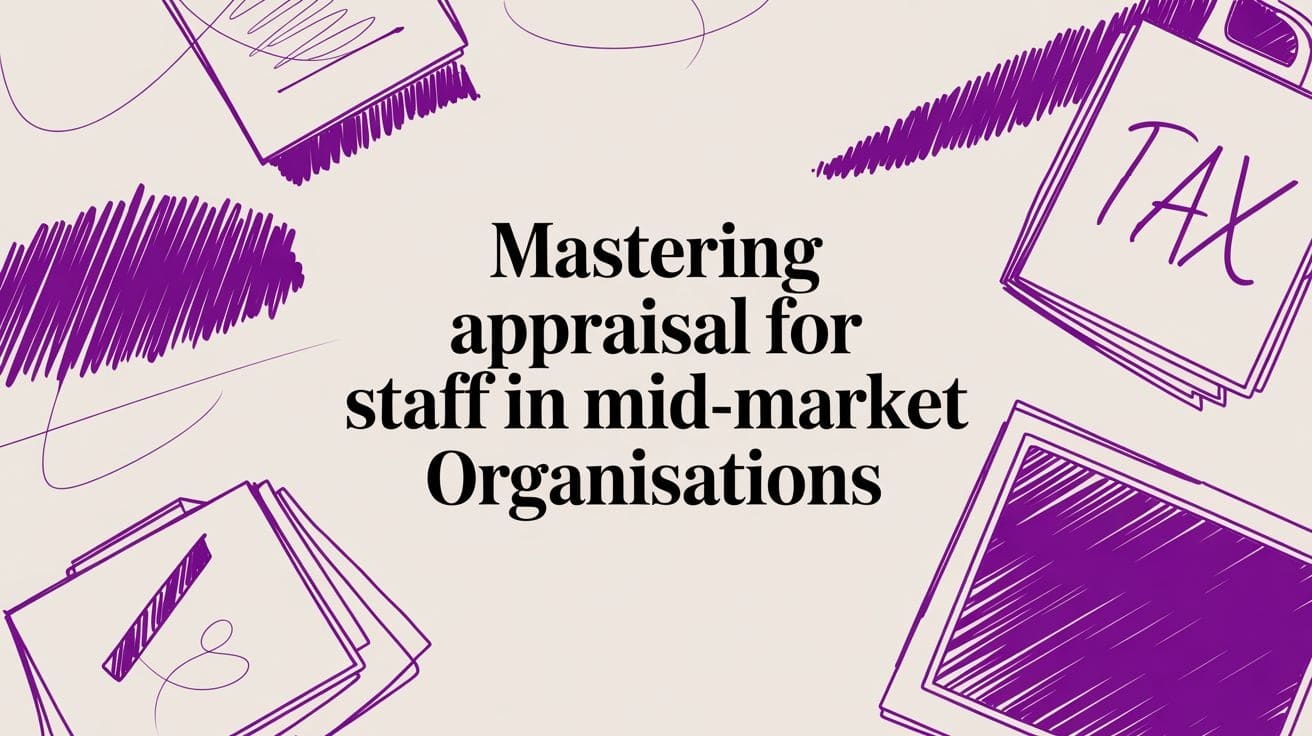Conducting right to work checks in the UK isn’t just a box-ticking exercise; it’s a legal must-have for every single employer. The whole point is to stop illegal working before it starts. In simple terms, you have to verify that every person you want to hire has the legal permission to work for you before their first day on the job. Get this right, and you shield your business from some seriously hefty fines and legal trouble.
Your Legal Duties for Right to Work Checks

As a UK employer, your role in preventing illegal working is a fundamental legal obligation, not just a bit of admin. This duty kicks in the second you decide to hire someone and doesn’t end. A slip-up isn’t treated as a minor clerical error—it’s viewed as a serious breach of immigration law.
Think of a properly conducted right to work check as your company’s insurance policy against crippling financial penalties. When you do it correctly and at the right time, you gain what’s known as a ‘statutory excuse’. This is your legal defence, the very thing that protects you from liability if it turns out an employee was working illegally despite your diligence. Without it, your business is completely vulnerable.
The Rising Cost of Non-Compliance
The financial stakes for getting this wrong have never been higher. The government is clamping down, with enforcement and penalties becoming much more severe. For any business, failing to comply is now a major financial risk.
The game has changed. It’s no longer enough to just say you did a check. You now need solid proof: evidence that the right checks were done correctly, on time, and with an audit trail that will hold up under scrutiny.
Recent rule changes really drive this point home. The fines for employing an illegal worker have shot up. A first-time mistake can cost you up to £45,000 per illegal worker. If it happens again, that figure jumps to an eye-watering £60,000 per worker. To give you an idea of how serious this is, over 1,500 civil penalty notices were handed out between mid-2024 and early 2025 alone.
Beyond Fines: The Broader Impact
The fallout from a failed right to work check goes way beyond the initial fine. The consequences can be devastating for a business and can include:
- Criminal Charges: If you knowingly hire someone without the right to work, you could face an unlimited fine and even up to five years in prison.
- Reputational Damage: Getting publicly named and shamed for non-compliance can wreck your brand’s reputation, making it harder to win customers and attract top talent.
- Loss of Sponsorship Licence: If you rely on a sponsor licence to hire skilled workers from abroad, a compliance failure could see it downgraded, suspended, or even revoked, completely cutting off your access to international talent.
Managing all of this properly means keeping meticulous records, which naturally brings data protection and GDPR into the picture. For a deeper dive into handling this sensitive data correctly, you can explore the privacy policy for Right to Work for Hubdrive HR. Ultimately, this isn’t just about dodging penalties; it’s about building a business on fair, ethical, and legal hiring practices.
When to Check and Who to Check
Getting the “when” and “who” of Right to Work checks right is where compliance truly begins. If you get the timing wrong or miss someone out, you could lose your statutory excuse against a civil penalty. The Home Office rules are very clear on this, and they’re designed to make sure the process is fair for everyone you hire.
The most important rule of thumb? Check everyone. It doesn’t matter if an applicant has a British passport, has lived in the UK their whole life, or sounds like a local. Picking and choosing who you check based on their appearance, name, or perceived nationality is a surefire way to face a discrimination claim. To keep your hiring process fair and legally watertight, you have to check every single person you plan to employ.
The Critical Timing Window
The check must be fully wrapped up before the employee starts their first day of work. This is a hard deadline with no wiggle room. If you do the check on their first day, or a few days in, it’s too late. You won’t have a valid statutory excuse. The check needs to be a standard part of your pre-employment process, happening after you’ve made a job offer but before any paid work actually starts.
Think of it like a pre-flight check on an aircraft. You wouldn’t wait until you’re halfway down the runway to see if everything is in order. The check must be done before the journey—or in this case, the employment—officially begins.
This applies to all types of workers you bring on board, including:
- Permanent employees
- Part-time staff
- Temporary or casual workers
- Student interns, whether they’re paid or not
Who Exactly Needs a Check?
The short answer is: every single person you intend to employ. There are no exceptions. Applying this rule universally is your best defence against any accusations of discrimination.
Let’s break it down with a few common scenarios to make it crystal clear:
- British Citizens: Yes. Even if you’re absolutely certain of their nationality, you must still see their original passport or another acceptable document to establish your statutory excuse.
- Sponsored Workers: Absolutely. You’ll need to verify their status, most likely using the Home Office’s online service. This needs to be done before they start, and you’ll likely need to do follow-up checks later on.
- Students: Yes. You not only need to confirm they have the right to work but also pay close attention to any restrictions on their working hours, especially during term time.
- EU, EEA, or Swiss Citizens: Yes. Since the post-Brexit rule changes, most will need to prove their status under the EU Settlement Scheme, which usually means providing you with a digital share code.
Don’t Forget About Follow-Up Checks
For some employees, the initial check isn’t a one-and-done deal. If someone has a time-limited right to work—like a student on a visa or someone on a temporary work visa—you have an ongoing responsibility to conduct follow-up checks.
You must schedule and carry out a repeat check just before their current permission is due to expire. If you miss this, you lose your statutory excuse from that point on. This makes having a reliable system for tracking visa expiry dates absolutely essential for staying compliant in the long run.
Choosing Between Manual and Digital Checks
Navigating the landscape of employee verification can feel a bit like a minefield, but it doesn’t have to be. As an employer in the UK, you have three distinct, government-approved ways to conduct Right to Work checks. Getting this right isn’t just about ticking a box; it’s about building a solid legal defence—your ‘statutory excuse’—and protecting your business from some pretty hefty fines.
So, what are your options?
- The classic manual document check.
- The Home Office online service, which works via a digital ‘share code’.
- Checks carried out by a certified Identity Document Validation Technology (IDVT) provider.
The crucial thing to remember is that you can’t just pick the one you like best. The right method depends entirely on the candidate’s nationality and their specific immigration status. Choosing the wrong path can completely invalidate the check, leaving your business exposed.
The Traditional Manual Check
For years, this was the only way. The manual check involves sitting down with a candidate—either in person or over a live video call—and physically examining their original documents. You’re looking to confirm the documents are genuine, the person in front of you is the person on the documents, and that they have the right to do the job you’re offering.
These days, this method is almost exclusively for British and Irish citizens who can show you a valid passport. While it sounds simple, the burden of spotting a fake rests squarely on your shoulders. If a forgery is good enough to be “reasonably apparent” and you miss it, your statutory excuse could go out the window.
The Shift to Digital Verification
The government is making a big push for employers to move towards digital checks, and for good reason. They’re far more secure and leave less room for human error. This move has given us two strong alternatives to the old paper-based process, especially when hiring non-British or non-Irish nationals.
This infographic breaks down the basic decision-making process for who needs a check.

The bottom line is crystal clear: every single person you plan to hire must have their Right to Work checked before they start their first day. No exceptions.
Comparing Right to Work Check Methods
To help you decide which route to take, it’s useful to see the three methods side-by-side. Each has its place, and understanding the nuances is key to staying compliant.
| Check Method | Applicable To | Key Process | Pros | Cons |
|---|---|---|---|---|
| Manual Check | British and Irish citizens with a valid passport (or Irish passport card). | Physically or virtually inspect original documents. Check for authenticity, verify the holder’s identity, and copy/store securely. | Simple for face-to-face onboarding. No technology required. | High risk of human error in spotting forgeries. Can be administratively burdensome. |
| Home Office Online Service | Most non-UK/Irish nationals, including those with eVisas or status under the EU Settlement Scheme. | Candidate generates a ‘share code’ online. Employer uses the code and the candidate’s date of birth to view their status directly on the GOV.UK website. | Highly secure and reliable (direct government source). Free to use. Quick and definitive. | Mandatory for many non-UK nationals; you cannot accept physical documents from them. Relies on the candidate to generate the code. |
| IDVT Service Provider | British and Irish citizens with a valid passport (or Irish passport card). An alternative to the manual check. | Candidate uploads images of their documents and a selfie to a certified provider’s app/platform. The provider uses tech to verify the documents and match the selfie. | Reduces the burden of forgery detection. Streamlines remote onboarding. Creates a consistent, auditable trail. | Incurs a per-check fee. Requires using a third-party service. |
As you can see, the digital methods offer much greater security, particularly the Home Office’s online service, which is now the only acceptable check for many international workers.
Understanding Share Codes and Online Checks
For anyone with an eVisa, Biometric Residence Permit (BRP), or status under the EU Settlement Scheme, the online check is now mandatory. They can no longer simply show you a physical permit; they must go online, generate a unique ‘share code’, and give it to you to complete the verification.
Using the Home Office online service isn’t just a preference; for a growing number of candidates, it is the only legally compliant method. Failing to use it when required means you have not performed a valid check.
This process is fast, free, and completely removes the guesswork, as you’re viewing information pulled directly from the Home Office database. For businesses that want to embed this process into their recruitment workflow, integrating these checks is the next logical step. You can integrate Right to Work checks into your existing HR platform for Dynamics 365 to build a seamless and fully compliant onboarding system.
Your Step-by-Step Compliance Checklist

To make sure every right to work check you do is watertight, you need a solid, repeatable process. This is about more than just glancing at a passport; it’s about verifying it correctly and keeping a flawless record. The Home Office has a clear three-stage approach that, when followed properly, gives you a ‘statutory excuse’ against penalties: Obtain, Check, and Copy.
Think of this checklist as your go-to playbook. By building these three stages into your onboarding workflow, you create a robust system that minimises risk and keeps everything consistent, whether you’re hiring your first employee or your hundredth. It’s a simple framework designed for busy hiring managers and HR teams to get it right every time.
Stage 1: Obtain
First things first, you need to get your hands on the candidate’s original documents. It’s absolutely vital that for a manual check, you don’t accept scans, photos, or photocopies. You must have the physical document in front of you.
The documents you can accept vary depending on the candidate’s nationality and immigration status. The Home Office helpfully splits these into two categories: List A and List B.
- List A Documents: These prove a person has a permanent right to work in the UK. A valid British passport is a classic example. If you check one of these correctly, you’ve established a continuous statutory excuse for their entire employment.
- List B Documents: These show a temporary right to work. When you check a document from this list, your statutory excuse is time-limited. This means you have to schedule a follow-up check before their permission to work runs out.
Stage 2: Check
This is the most hands-on part of the process and it’s where mistakes can easily happen. Get this wrong, and the entire check could be invalid, even if you have the right documents.
First, you have to verify the documents are genuine with the person present. This can be done face-to-face or over a live video call where they hold the original document up to the camera. You’re looking for any tell-tale signs that it’s a fake or has been tampered with.
Second, you need to be sure the document actually belongs to the person in front of you. This involves carefully comparing the photo on the document to the individual, whether they’re in the room or on the screen. Also, double-check that their date of birth and other details match the information they’ve already given you.
A common pitfall is failing to do the check with the person present. Just getting a passport in the post and photocopying it doesn’t count. You must verify the document’s authenticity and the holder’s identity at the same time.
Stage 3: Copy
The final piece of the puzzle is creating and keeping a legally sound record of the check you’ve just done. This record is your proof that you did everything by the book and must be available if the Home Office ever comes knocking.
Your copy must be clear and legible, showing the entire document. For a passport, that means copying any page with the holder’s photo, personal details, nationality, date of birth, signature, and expiry date. Don’t forget any pages that contain UK work permissions or endorsements.
Critically, you must also jot down the date the check was performed. A simple note on the copy like “Date of check: [DD/MM/YYYY]” is all you need. It’s also good practice to include the name of the person who carried out the check.
These copies need to be stored securely for the entire time the person works for you, plus for another two years after they’ve left. This isn’t just a suggestion—it’s a legal requirement, and failing to have these records can lead to fines.
By methodically following the Obtain, Check, and Copy framework for every single hire, you build a powerful defence against civil penalties and ensure your hiring practices are fair, consistent, and legally sound.
The Future of Home Office Enforcement
Staying compliant with right to work checks in the UK isn’t a one-and-done task; it’s a moving target. The Home Office is constantly updating its enforcement strategy, pushed forward by new technology and changing government priorities. To keep your business protected, you have to look beyond today’s rulebook and get ready for what’s coming next.
The direction of travel is crystal clear: everything is going digital. The days of relying entirely on photocopies of passports tucked away in a filing cabinet are numbered. The Home Office is nudging, and in some cases forcing, employers towards digital-first verification. It’s seen as more secure, more efficient, and much harder for people to cheat. This whole shift is about building a tougher system to stop illegal working before it even starts.
The Rise of Digital-First Audits
As the checks move online, so does the enforcement. You should expect Home Office audits to become more common and much more focused on your digital footprint. Their teams will be poring over your digital records of online checks, how you manage share codes, and the reports from your IDVT provider. If your system is a chaotic mess of spreadsheets and emails, it’s going to raise a massive red flag.
The government’s plan is no secret. They’ve laid out a strategy to ramp up employer accountability, deploying hundreds of new Home Office staff to target high-risk sectors. Think about industries like the gig economy or hospitality, where illegal working has historically been a bigger problem. If you’re in one of those sectors, the chances of an unexpected visit just went up significantly. You can find more detail in the government’s strategy for employer compliance.
Preparing for a Potential Audit
The only way to get through an audit without a panic is to be prepared from day one. You need a compliance system that isn’t just solid but also completely transparent. Put yourself in an inspector’s shoes: could you pull up the complete right to work history for any employee, current or former, in a matter of minutes?
Here’s what you need to do to get your house in order:
- Centralise Your Records: Keep everything in one place. Whether it’s a digital report or a certified copy of a physical document, it needs to be in a single, secure, and easily accessible system.
- Train Your Team: Make sure anyone involved in hiring knows the latest rules inside out—for manual, online, and IDVT checks. A single mistake can put the entire company at risk.
- Schedule Follow-Up Checks: This is crucial. You absolutely must have a reliable system for tracking and re-checking employees whose permission to work is time-limited. Missing just one of these can completely wipe out your statutory excuse.
As things like biometric technology and eVisas become the norm, this digital trend is only going to speed up. These systems make verification quicker and more accurate, but they also give the Home Office a much clearer view of who is working where. A clean, compliant digital trail is no longer a ‘nice-to-have’—it’s an absolute necessity.
At the end of the day, Home Office enforcement is getting smarter and more reliant on data. By embracing the right digital tools, keeping meticulous records, and staying on top of regulatory changes, you can build a compliance process that not only meets today’s standards but is ready for whatever comes next.
Frequently Asked Questions
When it comes to right to work checks in the UK, it’s the specific, real-world questions that often trip employers up. Get these wrong, and you could find yourself in serious hot water. We’ve pulled together some of the most common queries we hear to give you clear, straightforward answers.
What Happens if an Employee’s Right to Work Expires?
This is a big one. If an employee has a time-limited right to work, your job isn’t done after the first check. The law says you must conduct a follow-up check just before their current permission is due to end. Think of it as a crucial compliance checkpoint.
If they can’t show you proof that their right to work has been renewed or extended, you have to let them go. It’s a tough situation, but continuing to employ someone without a valid right to work means you instantly lose your ‘statutory excuse’. That leaves your business wide open to hefty civil penalties—up to £45,000 for a first-time mistake.
A rock-solid system for tracking visa expiry dates isn’t just nice to have; it’s a must. Missing a single follow-up check can be just as costly as skipping the initial one altogether.
Can I Accept a Scanned Passport for a Manual Check?
In a word, no. For a manual right to work check, the rules are crystal clear: you have to see the original, physical document with your own eyes. A scan, a photo, or even a high-quality photocopy just won’t cut it and will leave you without a statutory excuse.
You need to verify the original document while the person is present. This can be face-to-face or over a live video call where they hold the document up to the camera. The whole point is for you to be satisfied that the document is genuine and belongs to the person in front of you. And remember, for most non-UK/Irish citizens who now have a digital immigration status, you’ll need to use the Home Office online service instead anyway.
How Long Must I Keep Right to Work Records?
Your responsibility for these records doesn’t end when an employee walks out the door for the last time. You are legally required to keep a clear, unalterable copy of the check—whether it’s the document copies or the digital ‘profile’ from an online check—for the entire time the person works for you.
But it doesn’t stop there. You must hold onto these records for a further two years after their employment has ended. This is non-negotiable.
Make sure your records are:
- Stored securely to meet GDPR requirements.
- Kept in a format that can’t be altered.
- Readily available should the Home Office ever ask to see them.
Failing to produce the right records during an inspection can lead to penalties, even if you did the initial checks perfectly. A well-organised record-keeping system is the bedrock of your compliance.
Getting it Right, Every Time
Let’s be honest: navigating the world of UK Right to Work checks can feel like walking through a minefield. It’s complex, the rules change, and the stakes are incredibly high. Getting it wrong isn’t just a minor slip-up; it can lead to eye-watering fines and serious legal headaches.
But you don’t have to go it alone. If you’re looking for a bit of clarity or need a hand building a truly solid, compliant process, we’re here to help.
For businesses running on Microsoft Dynamics 365, embedding these checks directly into your HR system is the ultimate safety net. It takes the guesswork out of the equation. You can learn more about how this works with our Right to Work Solution Add-on for Human Resources Management for Dynamics 365 by Hubdrive.
Let’s make sure you’re protected.
Phone 0845 855 0000 today.



